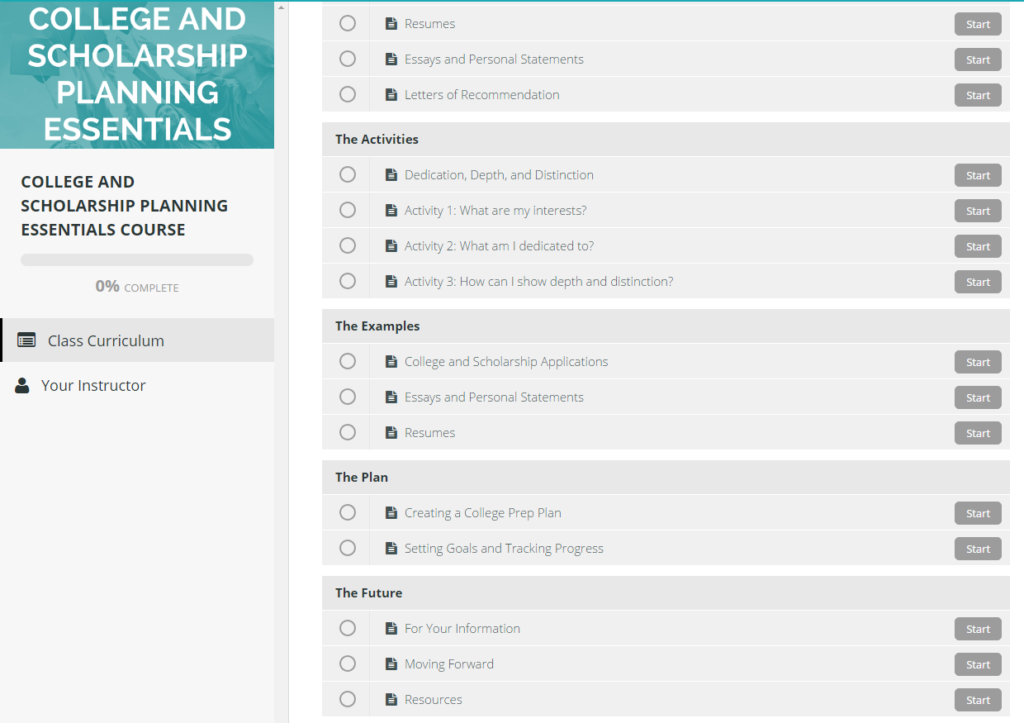Getting organized is the first step to helping your student get accepted to the college of their dreams and earn the scholarships to pay for it. This essential step will ensure that your child’s college or scholarship applications are complete – that nothing is forgotten or missed.
The best way to do this is with a physical organizer. Yes, we live in a digital world, but the most effective way to keep your monthly commitment to planning is to have that physical component. You will need physical copies of letters of recommendation, resumes, cover letters, and other application documents. On top of that, research shows that writing down your commitments and goals by hand will actually help you accomplish them. The Organizer is the tool that you will keep on your desk at home as a physical reminder to sit down with your student each month to do a little planning and goal setting. The ScholarPrep Organizer was designed specifically to help you prepare for the application process without any stress! It ensures your student’s applications are complete and it saves time!
So you’re probably wondering, if getting organized is just the first step, what’s the second?
Well, to answer this, we first need to answer a more important question.
What is the ultimate purpose of an application?
Here are some answers we often hear from parents and students:
- Get accepted
- Set yourself apart from other applicants
- Paint a picture of who you are
- Tell them why they should pick you
- Demonstrate you deserve the scholarship
These are all correct! An application really has one job and that is to answer the reviewer’s questions. The tricky part is that they might have several questions. When they read through the application, they may want to know:
- Why should we pick you over another applicant?
- How did you make a positive impact on your community?
- What have you done over the last four years?
- How did you spend your free time in high school?
- What makes you unique?
- What value would you add to our college or university?
- Why do you deserve this scholarship?
So, how do you do that? How can your student clearly demonstrate who they are and what sets them apart? How can they know that their application is doing its job to the fullest?
When we created the ScholarPrep Organizer, it was to give parents and students a tool for getting organized. Now we have created a solution specifically to help students and parents navigate this second part of the process. In July 2016, we will be launching an online course to help you pinpoint exactly how you can make sure your child’s applications stand out! By helping families through the planning process, we have gained an appreciation for the fact that every student is different and every situation is different, so, while our Organizer can help everyone get organized, it can’t answer your specific questions about how your child should be spending their time during high school. Let me give you an example:
I recently had a mom ask me how her son could get more volunteer experience. He had been involved in a couple of school fundraisers and volunteered at a 5K, but she was having a hard time motivating him to get more involved in community service. After we talked through all of his interests and skills, it became obvious that he was not interested in doing more volunteer work like this and it would be a constant battle between them if she kept pushing him to. The good news is, he didn’t need to do volunteer work that he hated! Not only would that create conflict between them, it also wasn’t going help create a more impressive application. Instead, I suggested that he take his skills and passion for computer science and turn that into a volunteer opportunity, by helping a local nonprofit organization update their website. This way, he would enjoy the community service, build his skills and demonstrate leadership experience at the same time!
Now this parent in particular is one of our mentoring clients, which means we work one-on-one with her and her son every month to create the best possible application so that he will get accepted to his top choice school and earn the scholarships to pay for it. We love being able to provide individualized support to our parents and students. So, we have taken our new course one step further by including a college planning session with an experienced ScholarPrep Mentor in our premium course bundle. Choosing this option will allow you to ask questions about your student’s specific situation and interests and get one-on-one support while you create a custom college prep plan!
Our brand new course will take you through several modules and brainstorming activities developed to help you and your student answer those exact questions we listed above – ultimately you will discover what to include on the applications to demonstrate that your student is the best applicant! Over the first of seven modules, we will walk you through the details of the ScholarPrep System. We will get into the importance of making a monthly commitment to planning and reveal exactly what activities students should be recording so that they are prepared to fill out applications. We will also give you valuable tips and information so that you will know what to expect from the application process.
Then we will get into some brainstorming activities that will help your child identify how they should be spending their time during high school.
This is the only way to ensure impressive college and scholarship applications.
You will see real examples of applications, resumes, and essays. Finally, we will help you create a custom college prep plan and give you resources for easily implementing your plan and tracking your progress!
Below is a sneak peek of the curriculum. We use an amazing online teaching platform that allows you to access the course from anywhere at any time so that you can work through the material with your student at your own pace.
![course curriculum 1]()
![course curriculum 2]()
Until the end of June, we are offering a special pre-enrollment discount! If you sign up for any of the course levels by June 30th, you will receive $25 OFF. Just use the promo code EARLYBIRD25.
We are offering three different course levels, so that you can pick the one that will work best for you and your student. Our Essentials Course is the 7-module course that you see above. We also have the Essentials Course Bundle which includes one of our comprehensive ScholarPrep Organizers –the ideal companion to the course! Then we have our Premium Course Bundle, which includes the Organizer and a 30-minute planning session. We recommend picking one of the course levels that includes an Organizer because having that physical component is the only way to take advantage of the comprehensive tracking and organizational part of the system we have created for you.
Before you enroll, I want to share what one of our clients recently had to say after working with us:
“It was great for my son to meet and hear from someone— that is not one of his parents— about the importance of community involvement and some of those things he is lacking. At the same time you gave me peace of mind in knowing that while we are barely getting started, we are on the right path.”
The key thing here is that peace of mind. That’s what we hear most often, because so many parents just don’t know where to start or what to do. The great thing about this course is that we walk you through the entire process so that you know you aren’t missing out on anything.
We are here to ensure that your student will be prepared to compete for acceptance into the college of their dreams and earn the scholarships they need to pay for it, but this is a limited time offer. The price of this course and the bundles will go up after June 30th. By enrolling now, you will receive our $55 Organizer, life-time access to our college planning course and a one-on-one mentoring session for just $172. This is a small investment to make for peace of mind knowing that you have done everything to ensure that your student will be prepared.
CLICK HERE TO ENROLL IN THE COURSE
The post Learn how to create impressive college and scholarship applications appeared first on ScholarPrep.
![]()









 We are firm believers in the fact that just taking the test will help you increase your score, because you will get more comfortable with the format and your strategies.
We are firm believers in the fact that just taking the test will help you increase your score, because you will get more comfortable with the format and your strategies.












